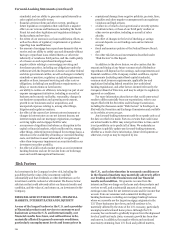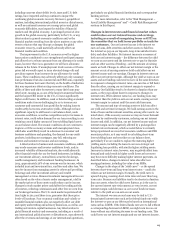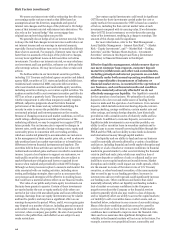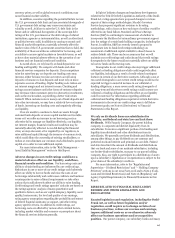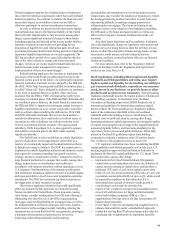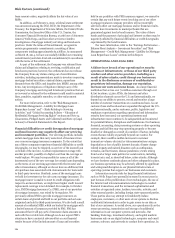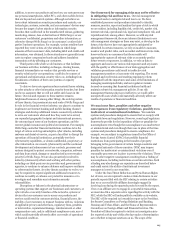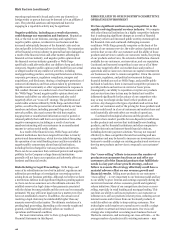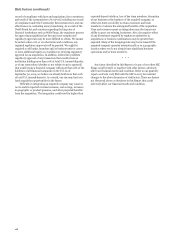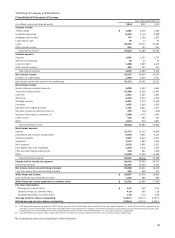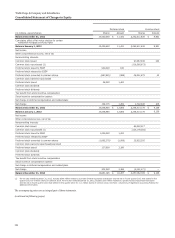Wells Fargo 2014 Annual Report Download - page 126
Download and view the complete annual report
Please find page 126 of the 2014 Wells Fargo annual report below. You can navigate through the pages in the report by either clicking on the pages listed below, or by using the keyword search tool below to find specific information within the annual report.Risk Factors (continued)
from consent orders, negatively affects the fair value of our
MSRs.
In addition, on February 9, 2012, a federal/state settlement
was announced among the DOJ, HUD, the Department of the
Treasury, the Department of Veterans Affairs, the Federal Trade
Commission, the Executive Office of the U.S. Trustee, the
Consumer Financial Protection Bureau, a task force of Attorneys
General, Wells Fargo, and four other servicers related to
investigations of mortgage industry servicing and foreclosure
practices. Under the terms of this settlement, we agreed to
certain programmatic commitments, consisting of three
components totaling approximately $5.3 billion. As announced
on March 18, 2014, we have successfully fulfilled our remaining
commitments (and state-level sub-commitments) in accordance
with the terms of this settlement.
As part of the settlement, the Company was released from
claims and allegations relating to servicing, modification and
foreclosure practices; however, the settlement does not release
the Company from any claims arising out of securitization
activities, including representations made to investors respecting
mortgage-backed securities; criminal claims; repurchase
demands from the GSEs; and inquiries into MERS, among other
items. Any investigations or litigation relating to any of the
Company’s mortgage servicing and foreclosure practices that are
not covered or released by the settlement could result in material
fines, penalties, equitable remedies, or other enforcement
actions.
For more information, refer to the “Risk Management –
Credit Risk Management – Liability for Mortgage Loan
Repurchase Losses” and “– Risks Relating to Servicing
Activities,” and “Critical Accounting Policies – Valuation of
Residential Mortgage Servicing Rights” sections and Note 14
(Guarantees, Pledged Assets and Collateral) and Note 15 (Legal
Actions) to Financial Statements in this Report.
Financial difficulties or credit downgrades of mortgage
and bond insurers may negatively affect our servicing
and investment portfolios. Our servicing portfolio includes
certain mortgage loans that carry some level of insurance from
one or more mortgage insurance companies. To the extent that
any of these companies experience financial difficulties or credit
downgrades, we may be required, as servicer of the insured loan
on behalf of the investor, to obtain replacement coverage with
another provider, possibly at a higher cost than the coverage we
would replace. We may be responsible for some or all of the
incremental cost of the new coverage for certain loans depending
on the terms of our servicing agreement with the investor and
other circumstances, although we do not have an additional risk
of repurchase loss associated with claim amounts for loans sold
to third-party investors. Similarly, some of the mortgage loans
we hold for investment or for sale carry mortgage insurance. If a
mortgage insurer is unable to meet its credit obligations with
respect to an insured loan, we might incur higher credit losses if
replacement coverage is not obtained. For example, in October
2011, PMI Mortgage Insurance Co. (PMI), one of our providers
of mortgage insurance, was seized by its regulator. We
previously utilized PMI to provide mortgage insurance on
certain loans originated and held in our portfolio and on loans
originated and sold to third-party investors. We also hold a small
amount of residential MBS, which are backed by mortgages with
a limited amount of insurance provided by PMI. PMI has
announced that it will pay 50% of insurance claim amounts in
cash with the rest deferred. Although we do not expect PMI’s
situation to have a material adverse effect on our financial
results because of the limited amount of loans and securities
held in our portfolios with PMI insurance support, we cannot be
certain that any such future events involving one of our other
mortgage insurance company providers will not materially
adversely affect our mortgage business and/or financial results.
We also have investments in municipal bonds that are
guaranteed against loss by bond insurers. The value of these
bonds and the payment of principal and interest on them may be
negatively affected by financial difficulties or credit downgrades
experienced by the bond insurers.
For more information, refer to the “Earnings Performance –
Balance Sheet Analysis – Investment Securities” and “Risk
Management – Credit Risk Management– Liability for Mortgage
Loan Repurchase Losses” sections in this Report.
OPERATIONAL AND LEGAL RISK
A failure in or breach of our operational or security
systems or infrastructure, or those of our third party
vendors and other service providers, including as a
result of cyber attacks, could disrupt our businesses,
result in the disclosure or misuse of confidential or
proprietary information, damage our reputation,
increase our costs and cause losses. As a large financial
institution that serves over 70 million customers through over
8,700 locations, 12,500 ATMs, the Internet and other
distribution channels across the U.S. and internationally, we
depend on our ability to process, record and monitor a large
number of customer transactions on a continuous basis. As our
customer base and locations have expanded throughout the U.S.
and internationally, and as customer, public, legislative and
regulatory expectations regarding operational and information
security have increased, our operational systems and
infrastructure must continue to be safeguarded and monitored
for potential failures, disruptions and breakdowns. Our business,
financial, accounting, data processing systems or other operating
systems and facilities may stop operating properly or become
disabled or damaged as a result of a number of factors including
events that are wholly or partially beyond our control. For
example, there could be sudden increases in customer
transaction volume; electrical or telecommunications outages;
degradation or loss of public internet domain; climate change
related impacts and natural disasters such as earthquakes,
tornados, and hurricanes; disease pandemics; events arising
from local or larger scale political or social matters, including
terrorist acts; and, as described below, cyber attacks. Although
we have business continuity plans and other safeguards in place,
our business operations may be adversely affected by significant
and widespread disruption to our physical infrastructure or
operating systems that support our businesses and customers.
Information security risks for large financial institutions
such as Wells Fargo have generally increased in recent years in
part because of the proliferation of new technologies, the use of
the Internet and telecommunications technologies to conduct
financial transactions, and the increased sophistication and
activities of organized crime, hackers, terrorists, activists, and
other external parties, including foreign state-sponsored parties.
Those parties also may attempt to fraudulently induce
employees, customers, or other users of our systems to disclose
confidential information in order to gain access to our data or
that of our customers. As noted above, our operations rely on the
secure processing, transmission and storage of confidential
information in our computer systems and networks. Our
banking, brokerage, investment advisory, and capital markets
businesses rely on our digital technologies, computer and email
systems, software, and networks to conduct their operations. In
124


